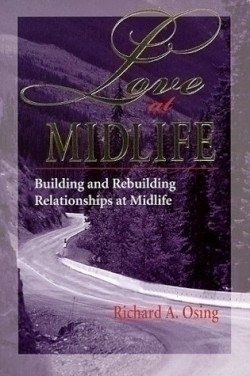Love at Midlife
Although he has experience as both a seminary graduate and a marriage counselor, author Richard Osing sticks to the secular in Love at Midlife. Indeed, it is chock full of brief, but detailed, case histories from his counseling. Some readers will find such “real life” anecdotes insightful; other readers might feel a bit like voyeurs.
The book, a quick read with the language of pop psychology, e.g. recreational sex, quality time, co-dependency, relies upon common sense. Reducing the problems of midlife change, including tired marriages, relationships, love, and divorce to simple analogies and basic models may be helpful to troubled readers. One such analogy is Osing’s five “buckets”—labeled attention, recognition, respect, affection, and separateness, which, he says, one needs to experience as full to feel loved. In another analogy, stepparents are understudies to stars. For those dealing with divorce, he supplies a grief model and a crisis model. The index has troubling lapses and is unclear; while “alcoholism” is not included, “buckets of need” is.
Osing offers several insights that are thought provoking and useful, such as his section on the importance of self-differentiation from parents, spouse, etc. Unfortunately, these are few and far between.
While sources are generously credited and his suggested reading list is long, Osing draws from so many personal growth experts (everyone from M. Scott Peck to Erich Fromm) that his work reads like an undergraduate sociology term paper. His overview of current self-help books about middle age might be a real eye-opener to some, but sophisticated readers might wish to pass on this book.
Reviewed by
Sally Ketchum
Disclosure: This article is not an endorsement, but a review. The publisher of this book provided free copies of the book to have their book reviewed by a professional reviewer. No fee was paid by the publisher for this review. Foreword Reviews only recommends books that we love. Foreword Magazine, Inc. is disclosing this in accordance with the Federal Trade Commission’s 16 CFR, Part 255.

